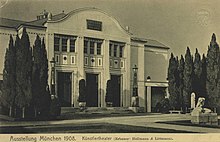Munich Art Theater
The Münchner Künstlertheater was a theater designed by Max Littmann in Munich in the former exhibition park on Theresienhöhe .
history
The Munich Art Theater Association was founded in 1907 . Its secretary and dramaturge on the artistic advisory board was the journalist and playwright Georg Fuchs . As a consequence of his reform ideas, he demanded the abolition of the ramp, which was to be replaced by an amphitheater with a row of boxes. Associated with this were his demands to overcome naturalism and return to the archetypal forms of the art of acting. The theater play should be renewed as a cult act. In this sense, Fuchs worked with the painter Fritz Erler .
The Munich Art Theater was designed by Max Littmann and opened in 1908. It was the first playhouse in Germany that was built according to the Art Nouveau aesthetic. The flat stage (relief stage ) and the lack of an orchestra pit were typical .
On 17 May 1908, the theater was Faust I opened. The program included William Shakespeare , August von Kotzebue , Josef Ruederer , Andreas Gryphius , Miguel de Cervantes and Georg Fuchs' dance legend . Although the first productions coordinated by Fuchs were not particularly successful, the building attracted a lot of attention.
In 1909 the association was dissolved and the theater leased to Max Reinhardt . Fuchs as theater director was now without influence on the artistic leadership. From 1911 to 1913 he and the Drei-Masken-Verlag were tenants. The game design took no account of the original reform ideas. The theater was finally closed in 1914. The building was destroyed during the bombing in World War II
literature
- Ingeborg Janich: Munich Art Theater . In: Manfred Brauneck, Gêrard Schnellin (ed.): Theater Lexikon 1. Terms and epochs, stages and ensembles . Rowohlt's encyclopedia published by Rowohlt Taschenbuch Verlag. Reinbek near Hamburg, November 1986, 5th completely revised new edition August 2007, ISBN 978 3 499 55673 9 , p. 678
